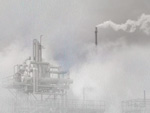South Central United States Air Quality Profile
 Sector Overview
Sector Overview Air quality issues in South Central USA, especially in large cities, are gaining in profile and starting to see large increases of public funding from federal, state and local entities.
Air quality in the five-states in this profile (Texas, Louisiana, Oklahoma, Kansas, and Arkansas) varies widely, with metropolitan areas often being EPA non-attainment zones, largely because of ozone levels. Arkansas typically ranks in the top third of the U. S. states for quality air. In January 2009, Louisiana announced for the first time in the state’s history that it met the federal ozone standards. Monitoring in Kansas shows the state to be in compliance with standards, although Kansas City fluctuates between attainment and non-attainment in ozone standards.
As considered in this profile, air pollution includes the following:
- U.S. Environmental Protection Agency (EPA) criteria pollutants: particulate matter, ozone, carbon monoxide, nitrogen dioxide, sulfur dioxide, and lead
- Greenhouse gases (GHG) produced by stationary sources, transportation, small engine emissions, and agriculture
- Toxic air pollutants, 188 pollutants identified by the EPA to have adverse health or environmental effects
Within the area considered in this profile, activities to reduce air pollution target emissions from
- Coal-fired power plants
- Transportation
- Chemical production and petroleum refining industries
- Small engine emissions
- Animal feeding operations (AFO)
Efforts to reduce EPA criteria pollutants and VOCs largely focus on emissions from transportation and from industrial activities, including chemical production and petroleum refining.
VOCs, which include chemicals contributing to ground-level ozone as well as toxic pollutants, are primarily an issue in the Houston area, with its high concentration of polymer plants. An August 2008 report prepared for the Texas Commission on Environmental Quality (TCEQ) analyzed the cost-effectiveness of 30 projects designed to control highly reactive VOC emissions from polymer plants in the Houston area. The study concluded that no single control technology could be universally applied and that TCEQ should collect additional information on the efficacy of flares in controlling emissions and on the correlation between emissions and production process.
In early 2007, Houston called on area industries to reduce benzene emissions; the proposal asked for industries to improve the procedural and/or control equipment to minimize emissions associated with maintenance, start-up, and shutdown activities. As a result, the city and the EPA began an investigation of benzene levels around Houston, which is ongoing.
Fine particles are primarily an issue in the vicinity of the Houston Ship Channel, which is home to heavy industry and a busy port. This area is the only place in Texas where the particulate-matter levels exceed the annual standard. Therefore, in response to this issue and to be at the forefront of environmental stewardship, the Port of Houston Authority strives for policies and programs that allow nature and industry to successfully coexist.
The Port Authority is committed to ensuring that PHA facilities are in compliance with environmental regulations. Moreover, PHA staff has been involved in a number of environmental activities, helping to develop programs for using dredge materials in a beneficial manner and for better management of dredge material disposal sites. (www.portofhouston.com)
Air pollution from animal feeding operations (AFO) is less studied than carbon and critical pollutant emissions from industrial sources. In June 2007, the EPA launched a two-year study to track particulate matter (PM); hydrogen sulfide; VOCs, and ammonia at animal production farms. The monitoring will involve 24 sites in nine states, including farms in Texas and Oklahoma.
Municipal programs
The City of Houston emissions reduction plan (August 2008) includes the purchase of one-third of the city government’s energy from wind power, contracting with energy service companies to increase efficiency, implementing a formal Environmental Management System for the three city airports, and reducing vehicle emissions through hybrid vehicles, diesel retrofits, and new diesel technology. (www.greenhoustontx.gov/index.html)
Commercial instrumentation and monitoring
New policies will likely provide an incentive for industrial facilities and power plants to perform more comprehensive monitoring to collect data applicable to proof of compliance and for cap-and-trade systems.
Carbon accounting systems
f a cap-and-trade policy is instituted in the U.S., corporations will require software and services to reduce, track, and trade carbon. The fact that the Canadian carbon-consulting company ClimateCheck was named by Time magazine (April 2008) as a top “green” start-up company attests to the importance of this new industry. Firms that have developed software for companies in Canada subject to provincial carbon taxes or who have marketed carbon-tracking software in Europe may have an advantage in the U.S. market.
Carbon capture and storage/clean coal technology
The construction of coal-fired power plants using carbon-capture and sequestration technology is not certain. However, the early endorsement of clean coal by the Obama administration will foster interest in such plants. One of the first and largest clean coal/carbon capture projects in the world is the SaskPower Boundary Dam Power Station, and the technologies used in that project should be of interest to stakeholders in U.S. coal-fired plants.
LEED-certified building designs and materials
Should the Obama administration proceed with grants for LEED-certified buildings, the availability of funding should spur some activity in the construction industry, particularly since tightening of credit has curtailed many construction projects across the U.S.
Canadian Government and Associations Contact
Consulate General of Canada in Houston
5847 San Felipe St., Suite 1700
Website: www.houston.gc.ca
Excerpts from: South Central United States Air Quality Profile, Canadian Trade Commissioner Service, 2009
You can return to the main Market News page, or press the Back button on your browser.

